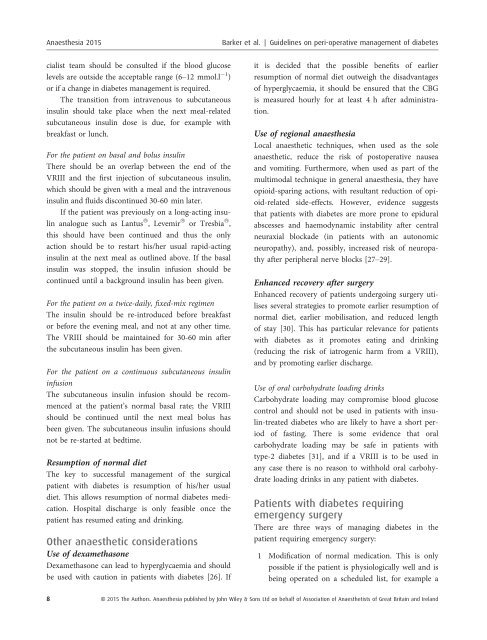pdfjoiner
Create successful ePaper yourself
Turn your PDF publications into a flip-book with our unique Google optimized e-Paper software.
Anaesthesia 2015<br />
Barker et al. | Guidelines on peri-operative management of diabetes<br />
cialist team should be consulted if the blood glucose<br />
levels are outside the acceptable range (6–12 mmol.l<br />
1 )<br />
or if a change in diabetes management is required.<br />
The transition from intravenous to subcutaneous<br />
insulin should take place when the next meal-related<br />
subcutaneous insulin dose is due, for example with<br />
breakfast or lunch.<br />
For the patient on basal and bolus insulin<br />
There should be an overlap between the end of the<br />
VRIII and the first injection of subcutaneous insulin,<br />
which should be given with a meal and the intravenous<br />
insulin and fluids discontinued 30-60 min later.<br />
If the patient was previously on a long-acting insulin<br />
analogue such as Lantus â , Levemir â or Tresbia â ,<br />
this should have been continued and thus the only<br />
action should be to restart his/her usual rapid-acting<br />
insulin at the next meal as outlined above. If the basal<br />
insulin was stopped, the insulin infusion should be<br />
continued until a background insulin has been given.<br />
For the patient on a twice-daily, fixed-mix regimen<br />
The insulin should be re-introduced before breakfast<br />
or before the evening meal, and not at any other time.<br />
The VRIII should be maintained for 30-60 min after<br />
the subcutaneous insulin has been given.<br />
For the patient on a continuous subcutaneous insulin<br />
infusion<br />
The subcutaneous insulin infusion should be recommenced<br />
at the patient’s normal basal rate; the VRIII<br />
should be continued until the next meal bolus has<br />
been given. The subcutaneous insulin infusions should<br />
not be re-started at bedtime.<br />
Resumption of normal diet<br />
The key to successful management of the surgical<br />
patient with diabetes is resumption of his/her usual<br />
diet. This allows resumption of normal diabetes medication.<br />
Hospital discharge is only feasible once the<br />
patient has resumed eating and drinking.<br />
Other anaesthetic considerations<br />
Use of dexamethasone<br />
Dexamethasone can lead to hyperglycaemia and should<br />
be used with caution in patients with diabetes [26]. If<br />
it is decided that the possible benefits of earlier<br />
resumption of normal diet outweigh the disadvantages<br />
of hyperglycaemia, it should be ensured that the CBG<br />
is measured hourly for at least 4 h after administration.<br />
Use of regional anaesthesia<br />
Local anaesthetic techniques, when used as the sole<br />
anaesthetic, reduce the risk of postoperative nausea<br />
and vomiting. Furthermore, when used as part of the<br />
multimodal technique in general anaesthesia, they have<br />
opioid-sparing actions, with resultant reduction of opioid-related<br />
side-effects. However, evidence suggests<br />
that patients with diabetes are more prone to epidural<br />
abscesses and haemodynamic instability after central<br />
neuraxial blockade (in patients with an autonomic<br />
neuropathy), and, possibly, increased risk of neuropathy<br />
after peripheral nerve blocks [27–29].<br />
Enhanced recovery after surgery<br />
Enhanced recovery of patients undergoing surgery utilises<br />
several strategies to promote earlier resumption of<br />
normal diet, earlier mobilisation, and reduced length<br />
of stay [30]. This has particular relevance for patients<br />
with diabetes as it promotes eating and drinking<br />
(reducing the risk of iatrogenic harm from a VRIII),<br />
and by promoting earlier discharge.<br />
Use of oral carbohydrate loading drinks<br />
Carbohydrate loading may compromise blood glucose<br />
control and should not be used in patients with insulin-treated<br />
diabetes who are likely to have a short period<br />
of fasting. There is some evidence that oral<br />
carbohydrate loading may be safe in patients with<br />
type-2 diabetes [31], and if a VRIII is to be used in<br />
any case there is no reason to withhold oral carbohydrate<br />
loading drinks in any patient with diabetes.<br />
Patients with diabetes requiring<br />
emergency surgery<br />
There are three ways of managing diabetes in the<br />
patient requiring emergency surgery:<br />
1 Modification of normal medication. This is only<br />
possible if the patient is physiologically well and is<br />
being operated on a scheduled list, for example a<br />
8 © 2015 The Authors. Anaesthesia published by John Wiley & Sons Ltd on behalf of Association of Anaesthetists of Great Britain and Ireland





